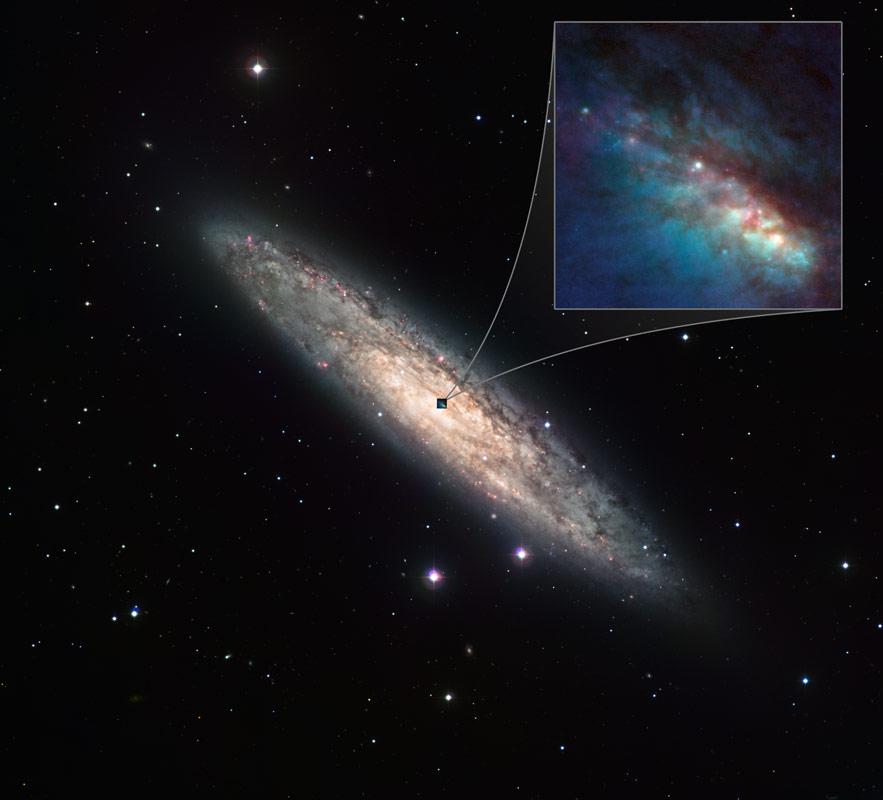"We have thus discovered what could be a twin of our Galaxy's Centre," says co-author Almudena Prieto, part of the group of astronomers from the Instituto de Astrofísica de Canarias (Spain) and lead author of a new paper on the topic, which also disclosed a group of new young, massive and dusty stellar nurseries there.
They used Adaptive Optics (AO) to correct for the blurring effect introduced by the Earth's atmosphere, the turbulence which makes the stars 'twinkle.' With AO in action the telescope can produce images that are as sharp as is theoretically possible, as if the telescope were in space.

NGC 253 is one of the brightest spiral galaxies in the sky, and also one of the dustiest. The whole galaxy is shown here as observed with the WFI instrument, while the insert shows a close-up of the central parts as observed with the NACO instrument on ESO's Very Large Telescope and the ACS on the NASA/ESA Hubble Space Telescope. This unique set of observations has allowed a team of astronomers from the Instituto de Astrofísica de Canarias (Spain) to study the galaxy in great detail, uncovering many young, massive and dusty stellar nurseries. They also found that the centre of this galaxy appears to harbour a twin of our own Milky Way's supermassive black hole. Credit: ESO
NACO revealed features in the galaxy that were only 11 light-years across.
"Our observations provide us with so much spatially resolved detail that we can, for the first time, compare them with the finest radio maps for this galaxy — maps that have existed for more than a decade," says Juan Antonio Fernández-Ontiveros.
Because observations in the radio wavelength domain are not affected by the turbulence of the atmosphere and because radio waves have much longer wavelengths than visible light, it is relatively easy to obtain very high spatial resolution at radio wavelengths by combining observations from well-separated radio telescopes (using interferometry). This is why, until recently, radio maps of galaxies show much more detail than their equivalents in the near-infrared or the optical.
Astronomers identified 37 distinct bright regions, a threefold increase on previous results, packed into a tiny region at the core of the galaxy, comprising just one percent of the galaxy's total size. The astronomers combined their NACO images with data from another VLT instrument, VISIR, as well as with images from the NASA/ESA Hubble Space Telescope and radio observations made by the Very Large Array and the Very Large Baseline Interferometer. Combining these observations, taken in different wavelength regimes, provided a clue to the nature of these regions.
Lying only 13 million light-years away from us, the spiral galaxy NGC 253 is one of the brightest in the sky. This sequence zooms into this nearly edge-on galaxy, starting with a "naked-eye" very wide-angle view, and then plunging into its heart, where a team of astronomers from Instituto de Astrofisíca de Canarias (Spain) discovered many young, massive and very dusty stellar nurseries. The sequence then blends from the visible light into a very high resolution composite of NACO images obtained with the VLT in the infrared, together with an ACS image from the NASA/ESA Hubble Space Telescope. In the final image, the stellar nurseries appear as reddish blobs near the centre of the Galaxy. Credit: ESO, NASA/ESA, Digitized Sky Survey 2 and A. Fujii
"We now think that these are probably very active nurseries that contain many stars bursting from their dusty cocoons," says Jose Antonio Acosta-Pulido, a member of the team. NGC 253 is known as a starburst galaxy, after its very intense star formation activity. Each bright region could contain as many as one hundred thousand young, massive stars.
Article: Fernandez-Ontiveros J.A., Prieto M.A.&Acosta-Pulido J.A., The nucleus of NGC 253 and its massive stellar clusters at parsec scales, MNRAS letters, 2009, 392, L16, DOI: 10.1111/j.1745-3933.2008.00575.x





Comments